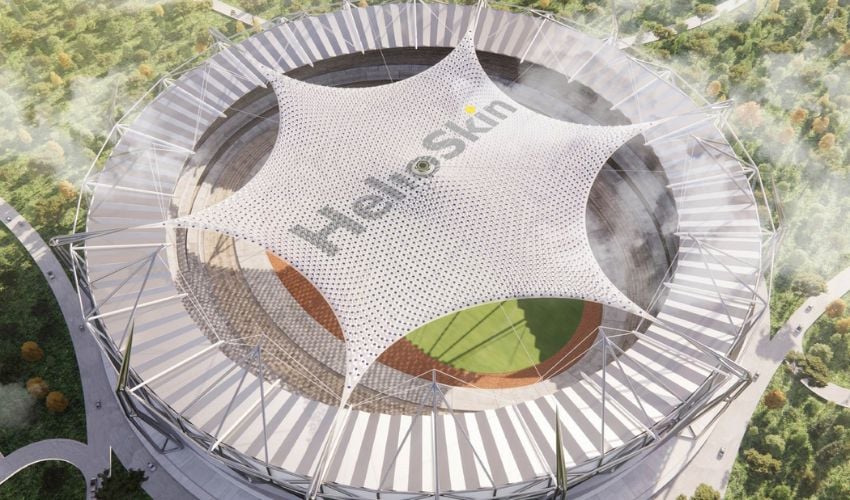HelioSkin: 3D Printed Adaptive Solar Panels

Solar panels as we know them are often flat, stationary, dark-colored panels that do not do much to add to the beauty of the environment. This limits where they can be placed and can discourage people from installing them. That is why researchers at Cornell University have dreamed up a way to make them more attractive and efficient. As part of the HelioSkin project, they have 3D printed photovoltaic panels as lightweight fabrics, a material that could be hinged together and wrapped around complex shapes for better absorbing sunlight.
HelioSkin is led by Jenny Sabin, the Arthur L. and Isabel B. Weisenberger Professor in Architecture in the College of Architecture, Art and Planning, in collaboration with Itai Cohen, professor of physics in the College of Arts and Sciences, and Adrienne Roeder, professor in the Section of Plant Biology in the School of Integrative Plant Science, in the College of Agriculture and Life Sciences and at the Weill Institute for Cell and Molecular Biology. Together, they are developing HelioSkin with the hopes of helping to reduce greenhouse gas emissions. And they are off to a strong start: In 2024, they were awarded $650,000 from the National Science Foundation’s Convergence Accelerator program, and for their next round of funding, the team applied to receive $5 million over three years.

Jenny Sabin with the rest of the team behind HelioSkin (photo credits: Ryan Young/Cornell University)
It is not just about design, either. The International Energy Agency estimates that 40% of total greenhouse gas emissions in the United States comes from building. Adopting solar could reduce 28% of CO2 coming from heating, lighting and cooling. Hardly an insignificant number. This is where projects like Sabin’s come in.
Biology-Inspired for Better Solar Products With HelioSkin
Sabin’s projects are all connected by the question of how buildings could behave more like organisms, adapting to their environments while also addressing a very real need. “Nature is not efficient,” Sabin said in an interview with the Cornell Chronicle. “It’s resilient, and biology is in it for the long game, over much longer time scales. Additionally, it has been demonstrated that plants that track the sun exhibit a photosynthetic advantage. And we think that’s a pretty powerful way to think about sustainability and resiliency in architecture.”
This can be seen with this project as the stem “helio-” comes from the Greek hēlios, meaning “sun.” One of the key inspirations of the HelioSkin project was studying heliotropism, which refers to the directional growth of a plant in response to sunlight. In fact, the project will combine architecture, engineering, mathematics and biology. For the latter, a plant called Arabidopsis was of particular use, as they studied it at a cellular level to better understand the role of cells in changing the curvature of the plant’s stem as it angles toward the sunlight.
The result? Well, for now it is centered on small solar canopies for backyards that can also be scaled up for urban parks. These were made with a combination of computational design, digital fabrication and 3D printing to create these customized filters and photovoltaic panel assemblies that can boost both light absorption and architectural beauty. The ultimate goal will be to generate a mechanically tracking solar-collection skin for retractable roofs, stadiums and even skyscrapers.

A closer look at HelioSkin which is a lightweight, stretchable architectural fabric (photo credits: Ryan Young/Cornell University)
“What we’re really passionate about is how the system could not only produce energy in a passive way, but create transformational environments in urban or urban-rural settings,” Sabin concludes. “Sustainability is about performance and function, but equally, it’s about beauty and getting people to get excited about it, so they want to participate. The grand goal is to inspire widespread adoption of solar for societal impact.”
The project is reminiscent of Solar Gate, a project wherein researchers from the University of Stuttgart and Freiburg were also inspired by nature for a self-sufficient façade system that adapts to changes in the weather. It shows a distinct trend in combing 3D printing and biomimicry for better projects. You can find out more about HelioSkin HERE.
What do you think of HelioSkin? Let us know in a comment below or on our LinkedIn, Facebook, and Twitter pages! Don’t forget to sign up for our free weekly Newsletter here, the latest 3D printing news straight to your inbox! You can also find all our videos on our YouTube channel.
*Cover Photo Credits: Jenny Sabin/Cornell University








Interested to acquire agency for Middle East and South Asia